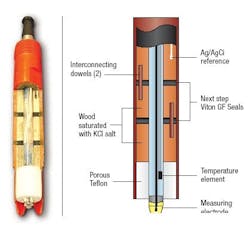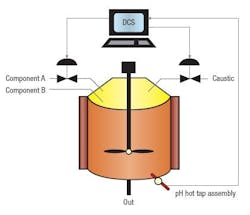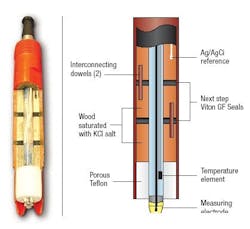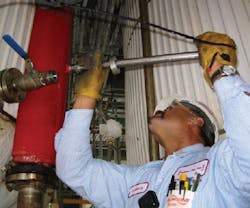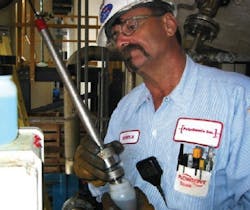Dependable pH control is vital for producing precursor polymer. The elements, or sensors, must operate over a wide pH range. Sensors must respond quickly and survive a harsh environment. Poor probe reliability can make the difference between a process that makes money and one that doesn’t.
Batch production of monomer
Polychemie, Pearlington, Miss., manufactures coagulant and solution flocculants for its parent company, SNF Inc. The Mississippi plant produces a monomer that’s a precursor for PolyDADMAC polymer (poly-diallyl, dimethyl ammonium chloride). The process takes two steps: charging raw materials, followed by separation. The measurement of pH has different roles during the two stages of the process. During the first stage, pH controls addition of a raw material at low pH; the second stage operates at a high pH (Figure 1).
Figure 1. Fine control is critical during first step in polymerization.
During this process, the reactor’s pH sensor is subjected to an extremely harsh and abrasive environment with temperatures ranging up to 180°F. Steam coils within the vessel’s jacket maintain the high temperatures.
Control functions
During the initial phase, two ingredients flow into the agitated reactor, mixing with an already present third material. pH is maintained by controlling the flow rate of one of the compounds. The stoichiometry in the reactor is managed by the pH loop. pH control also is important during the second process step, the stripping phase. In this step, water and residual organic matter are removed from the monomer product.
The plant recycles the excess organic materials. During the second step the reactor operates under vacuum at elevated temperature, and with a tight tolerance on alkalinity (9 pH to 10 pH). pH is used to control the rate of caustic addition. A high pH is required for stripping. Abrasive salts form during this phase, adding another threat to the pH probe in its environment. At the beginning of this phase the sensor must respond quickly to achieve product quality. A distributed control system terminates caustic addition at a predetermined value.
Finding a rugged pH sensor
Polychemie tried several types of pH sensors in the reactor, but none could long withstand the harsh environment. Shortly after installation, sensor response times slowed to a point that rendered the pH reading useless. Even flowing reference sensors, with both conventional glass and unique glass/steel measuring electrodes, quickly degraded in the harsh conditions.
Eventually the plant found success with the TB557 pH sensor from ABB Instrumentation (Figure 2).
Figure 2. Teflon and Viton provides some protection against reference contamination.
This unit consists of a hot-tap retractable sensor, which allows easy insertion or removal through a ball valve without disturbing the process. The plant now uses the sensors on four batch reactors.
ABB supplies the sensor complete with a ball valve assembly that bolts to a standard flanged port on the reactor. The sensor has a patented reference comprised of a matrix of immobilized KCl salt fronted by a porous Teflon junction. This “solid state” reference is almost immune to poisoning or the plugging problems that plague conventional liquid, slurry and gel-based references. Without this reference technology the sensor would be quickly destroyed during batch operations involving vacuum and extremely high pH.
The ABB probe’s sensitive hemispherical glass electrode is rugged enough to withstand abrasion and strong caustic. It is rated for a true 0 to 14 pH range at temperatures to 140°C (284°F). The body of the sensor is Kynar (PVDF) strengthened by a titanium sheath; both materials hold up well to the harsh process conditions. An integral cable and temperature element complete this rugged combination pH sensor.
The sensors have operated successfully at the Polychemie plant for about three years. Polychemie calibrates the pH sensors and transmitters from the four reactors on a weekly schedule. To do so, technicians simply retract the sensor, close the ball valve, and then remove the sensor for field calibration (Figures 3 ).
Figure 3. Sensor can be easily retracted through ball valve for calibration or inspection.
Technicians check the sensor and transmitter accuracies as well as the sensor response time (Figure 4).
Figure 4. Typical two-point calibration of retracted pH probe.
Because pH measurement is so critical to successful batch production of this monomer process, Polychemie replaces the sensors every six months as a matter of policy.
Kyle Becker is Maintenance Engineer for Polychemie in Pearlington, Miss. E-mail him at [email protected].
